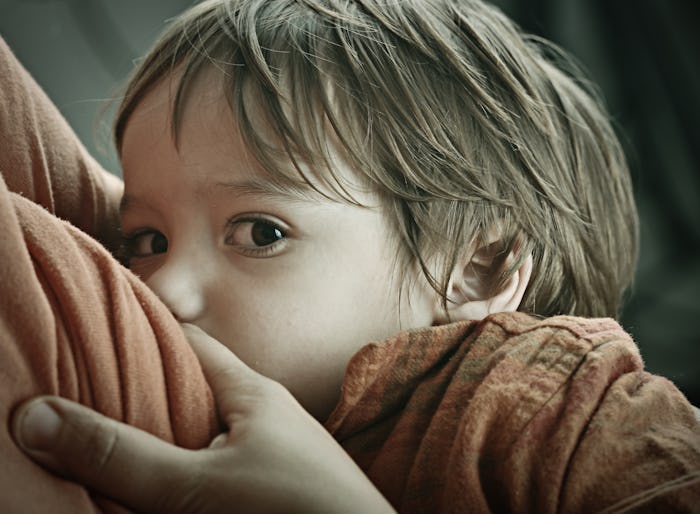Life

How Extended Breastfeeding Affects Your Boobs Later In Life
Extended breastfeeding, or nursing after the one-year mark, can have so many benefits to baby and mother as long as both want it. But regardless of how long you choose to nurse, your breasts are bound to go through some changes. And many moms who choose to go the extended route might eventually wonder how extended breastfeeding affects your boobs later in life: from their shape to their size to how far they droop.
Breastfeeding as a whole impacts how your breasts and nipples look and feel later down the road. According to WebMD, the flow of milk stretches your breast skin and tissue. In some women this stretch can cause their breasts to look flat and saggy. It's totally normal and not a medical issue, but the extent and severity of this cosmetic change isn't determined by how long or short you nurse your baby. It's just a common side effect of breastfeeding in general. Meaning you could have nursed your baby for one month, nine months, or two years and your breasts might've turned out the same regardless. The same site suggested that factors like age, genetics, body mass index, size of breasts pre-pregnancy, and number of pregnancies have more to do with breast changes than the actual breastfeeding itself.
It's also important to remember each breast is it's own entity. What happens to one, might not happen to the other. The same WebMD article noted that it's possible for one breast to sag more, or shrink more, or become one full cup size bigger than the other after breastfeeding. These asymmetric changes can happen whether you breastfeed briefly, a full year, or beyond.
The other area of the breast that can be impacted is the nipple. Many mothers complain of sore nipples, especially in those first days and weeks as they navigate nursing. However, Le Leche League International noted that if your nipples are persistently sore or in pain it could mean that your baby has a poor latch. Having a poor latch over a long period of time can cause serious nipple damage and even infection. It was difficult to find medical professionals or studies done on nipple trauma after breastfeeding, but one search brought up several threads of mothers complaining about shredded and inverted nipples after breastfeeding. Many of them asking if it was normal and if it will correct itself. According to the Baby Center, if you notice cracked nipples that means there is something wrong and you basically have two options: solve latching issues with your baby until the cracking stops or stop breastfeeding. If you have permanent damage to your nipples it may require surgery later.
Another cause of nipple trauma is improperly using breast pumps during breastfeeding. The same Baby Center article noted that if the suction is turned up too high or the breast shields being used are too small it could damage the nipple. It can be assumed that the longer you improperly use a pump in the case of extended breastfeeding, the more possible and permanent damage that could be done to your nipples.
Breastfeeding (and extended breastfeeding) is just one cause of temporary and permanent breast changes. Pregnancy in itself will cause your breasts to change, sometimes irreversibly. The ways and the extent to which your breasts change are often determined more by your age, genetics, and weight, rather than your choice to breastfeed or extend breastfeeding. It's pretty much guaranteed that your breasts will change regardless after a baby. The most paramount thing about these changes is learning to eventually embrace and accept them.